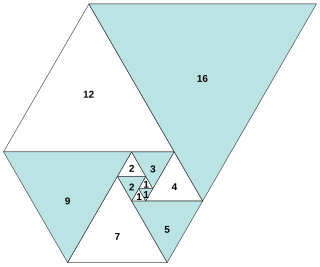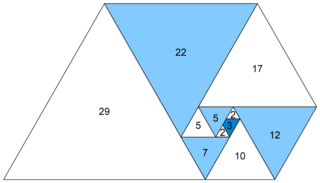In mathematics and computer science, Horner's method is an algorithm for polynomial evaluation. Although named after William George Horner, this method is much older, as it has been attributed to Joseph-Louis Lagrange by Horner himself, and can be traced back many hundreds of years to Chinese and Persian mathematicians. After the introduction of computers, this algorithm became fundamental for computing efficiently with polynomials.
In mathematics, a polynomial is a mathematical expression consisting of indeterminates and coefficients, that involves only the operations of addition, subtraction, multiplication and exponentiation to nonnegative integer powers, and has a finite number of terms. An example of a polynomial of a single indeterminate x is x2 − 4x + 7. An example with three indeterminates is x3 + 2xyz2 − yz + 1.
The Collatz conjecture is one of the most famous unsolved problems in mathematics. The conjecture asks whether repeating two simple arithmetic operations will eventually transform every positive integer into 1. It concerns sequences of integers in which each term is obtained from the previous term as follows: if a term is even, the next term is one half of it. If a term is odd, the next term is 3 times the previous term plus 1. The conjecture is that these sequences always reach 1, no matter which positive integer is chosen to start the sequence. The conjecture has been shown to hold for all positive integers up to 2.95×1020, but no general proof has been found.
In mathematics, a Sheffer sequence or poweroid is a polynomial sequence, i.e., a sequence (pn(x) : n = 0, 1, 2, 3, ...) of polynomials in which the index of each polynomial equals its degree, satisfying conditions related to the umbral calculus in combinatorics. They are named for Isador M. Sheffer.
In algebra, the partial fraction decomposition or partial fraction expansion of a rational fraction is an operation that consists of expressing the fraction as a sum of a polynomial and one or several fractions with a simpler denominator.
In algebraic topology, the Betti numbers are used to distinguish topological spaces based on the connectivity of n-dimensional simplicial complexes. For the most reasonable finite-dimensional spaces, the sequence of Betti numbers is 0 from some point onward, and they are all finite.
37 (thirty-seven) is the natural number following 36 and preceding 38.
In mathematics, the Fibonacci polynomials are a polynomial sequence which can be considered as a generalization of the Fibonacci numbers. The polynomials generated in a similar way from the Lucas numbers are called Lucas polynomials.

In mathematics, the look-and-say sequence is the sequence of integers beginning as follows:
A divisibility rule is a shorthand and useful way of determining whether a given integer is divisible by a fixed divisor without performing the division, usually by examining its digits. Although there are divisibility tests for numbers in any radix, or base, and they are all different, this article presents rules and examples only for decimal, or base 10, numbers. Martin Gardner explained and popularized these rules in his September 1962 "Mathematical Games" column in Scientific American.

In mathematics, the Pell numbers are an infinite sequence of integers, known since ancient times, that comprise the denominators of the closest rational approximations to the square root of 2. This sequence of approximations begins 1/1, 3/2, 7/5, 17/12, and 41/29, so the sequence of Pell numbers begins with 1, 2, 5, 12, and 29. The numerators of the same sequence of approximations are half the companion Pell numbers or Pell–Lucas numbers; these numbers form a second infinite sequence that begins with 2, 6, 14, 34, and 82.
A pseudorandom binary sequence (PRBS), pseudorandom binary code or pseudorandom bitstream is a binary sequence that, while generated with a deterministic algorithm, is difficult to predict and exhibits statistical behavior similar to a truly random sequence. PRBS generators are used in telecommunication, such as in analog-to-information conversion, but also in encryption, simulation, correlation technique and time-of-flight spectroscopy. The most common example is the maximum length sequence generated by a (maximal) linear feedback shift register (LFSR). Other examples are Gold sequences, Kasami sequences and JPL sequences, all based on LFSRs.

In number theory, the Padovan sequence is the sequence of integers P(n) defined by the initial values
In number theory, a Frobenius pseudoprime is a pseudoprime, whose definition was inspired by the quadratic Frobenius test described by Jon Grantham in a 1998 preprint and published in 2000. Frobenius pseudoprimes can be defined with respect to polynomials of degree at least 2, but they have been most extensively studied in the case of quadratic polynomials.
In mathematics, the Schwartz–Zippel lemma is a tool commonly used in probabilistic polynomial identity testing. Identity testing is the problem of determining whether a given multivariate polynomial is the 0-polynomial, the polynomial that ignores all its variables and always returns zero. The lemma states that evaluating a nonzero polynomial on inputs chosen randomly from a large-enough set is likely to find an input that produces a nonzero output.
In mathematics, the degree of a polynomial is the highest of the degrees of the polynomial's monomials with non-zero coefficients. The degree of a term is the sum of the exponents of the variables that appear in it, and thus is a non-negative integer. For a univariate polynomial, the degree of the polynomial is simply the highest exponent occurring in the polynomial. The term order has been used as a synonym of degree but, nowadays, may refer to several other concepts.
The Leonardo numbers are a sequence of numbers given by the recurrence:
In mathematics, Hermite numbers are values of Hermite polynomials at zero argument. Typically they are defined for physicists' Hermite polynomials.
In 1997, Moni Naor and Omer Reingold described efficient constructions for various cryptographic primitives in private key as well as public-key cryptography. Their result is the construction of an efficient pseudorandom function. Let p and l be prime numbers with l |p−1. Select an element g ∈ of multiplicative order l. Then for each (n+1)-dimensional vector a = (a0,a1, ..., an)∈ they define the function

In mathematics, the Perrin numbers are a doubly infinite constant-recursive integer sequence with characteristic equation x3 = x + 1. The Perrin numbers bear the same relationship to the Padovan sequence as the Lucas numbers do to the Fibonacci sequence.
















